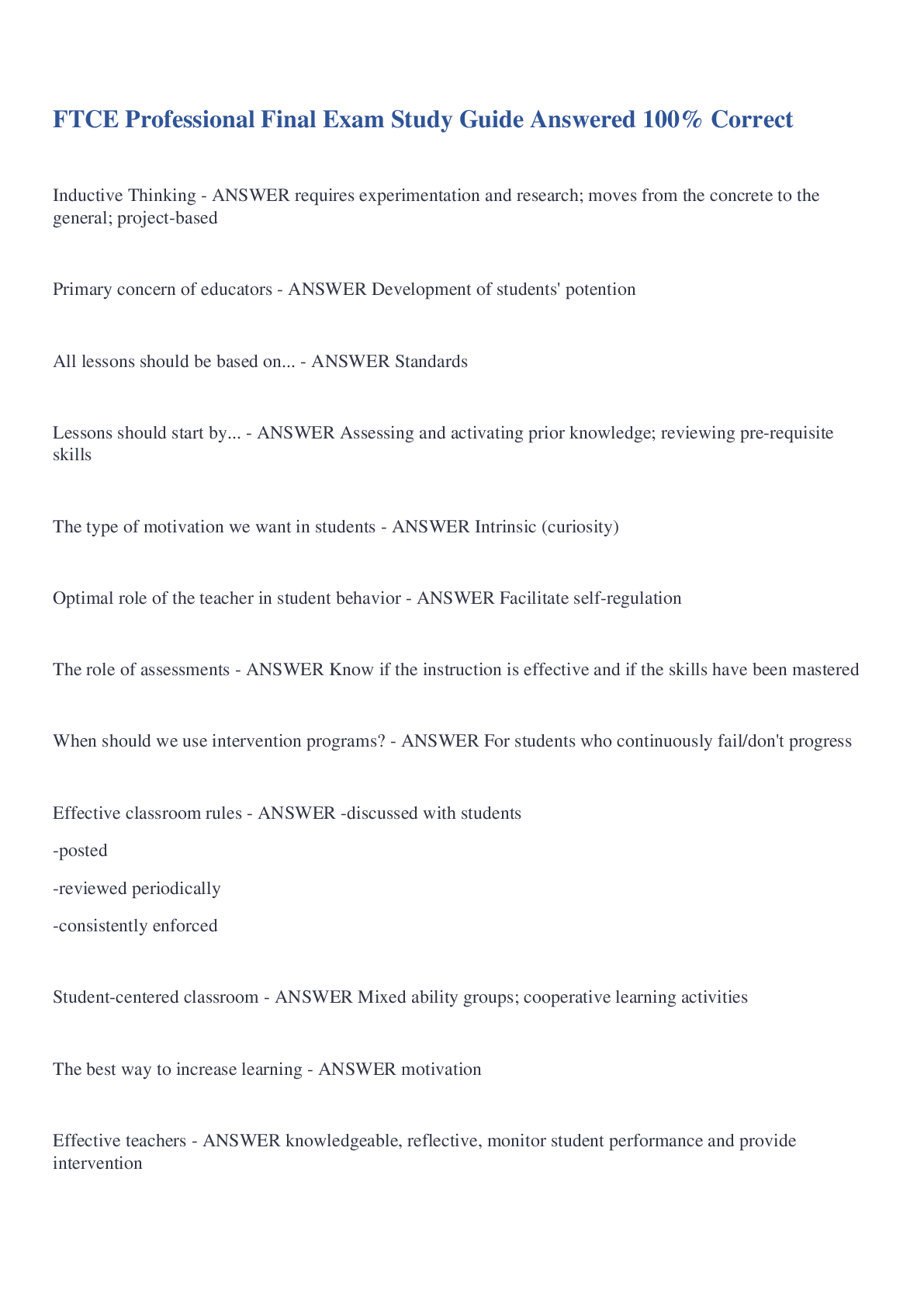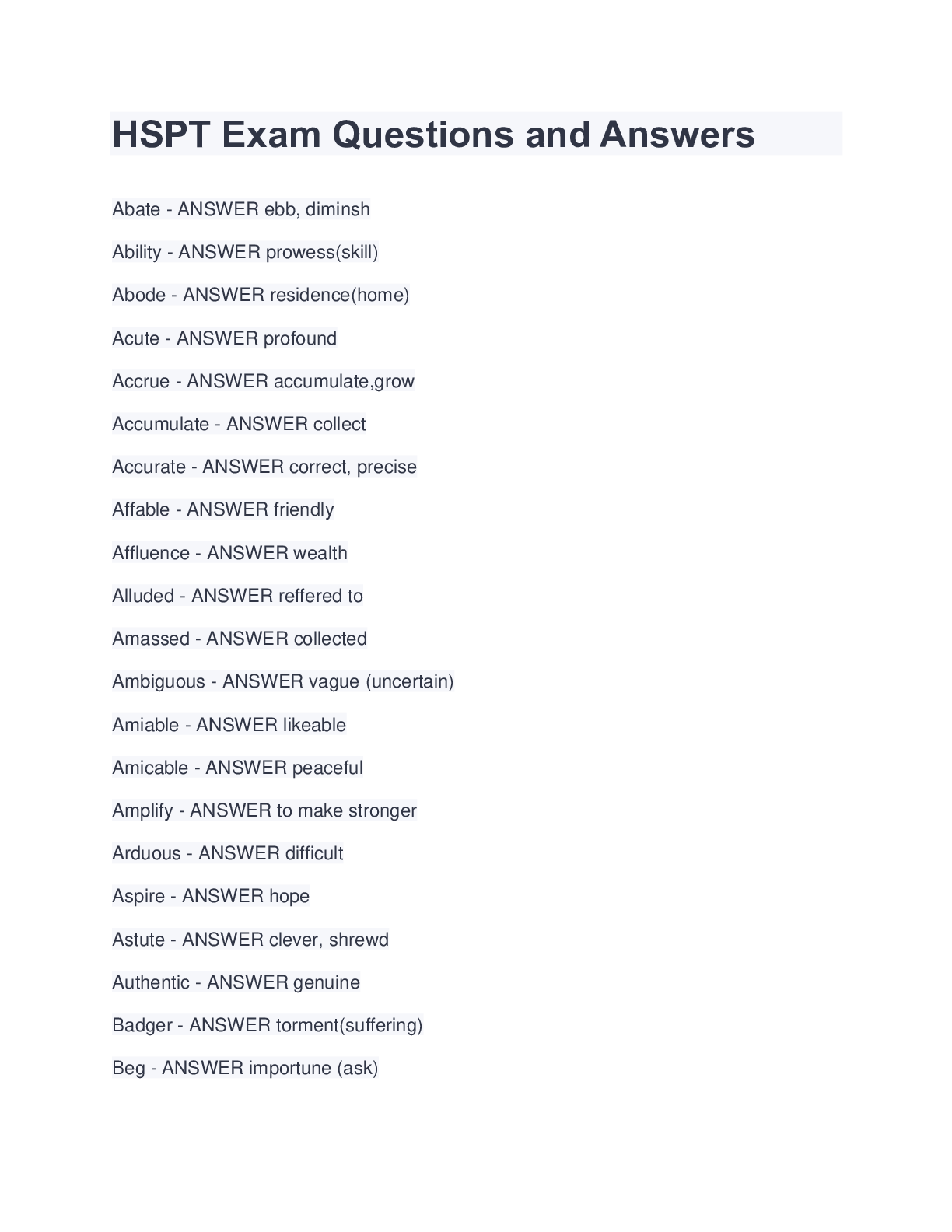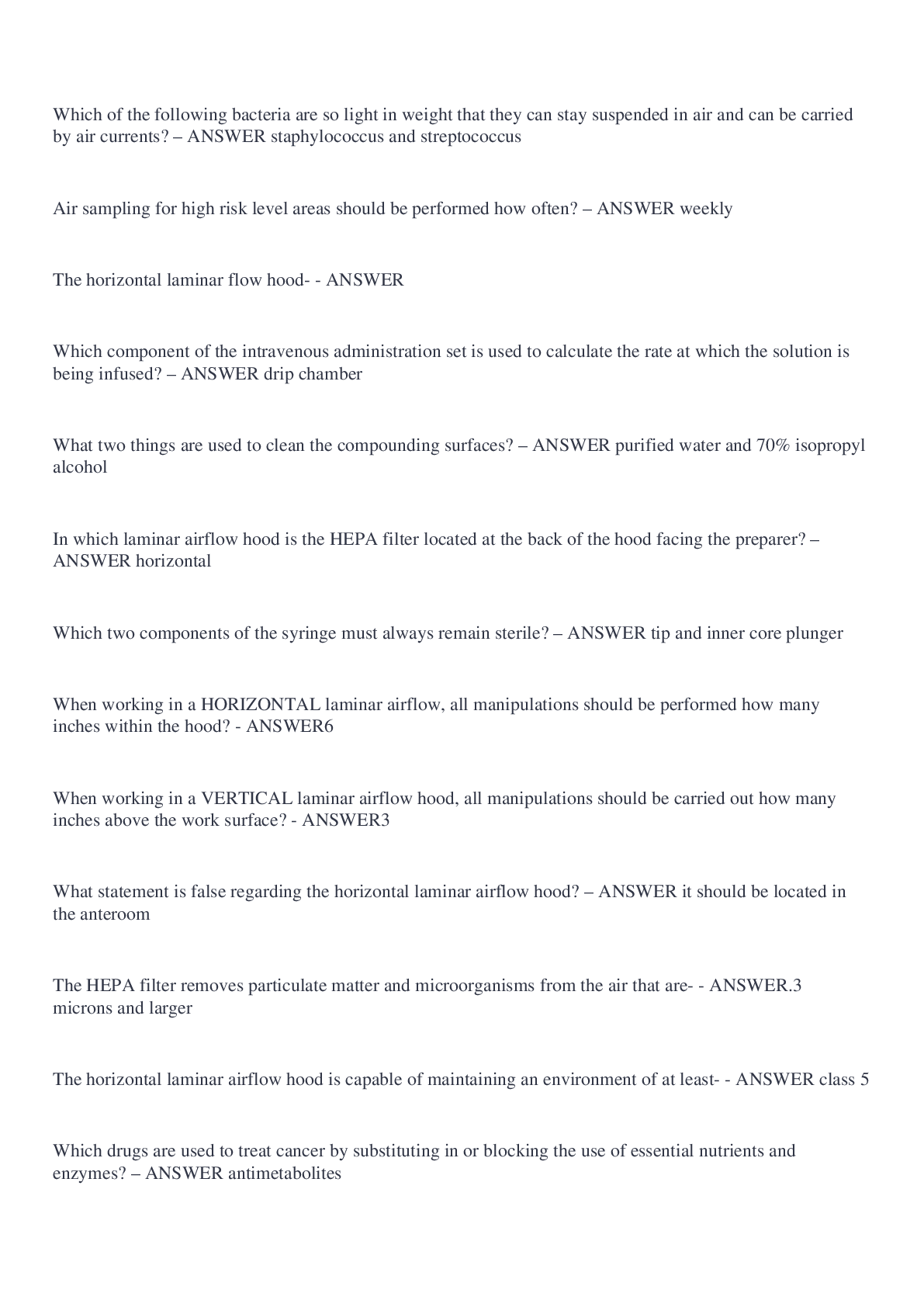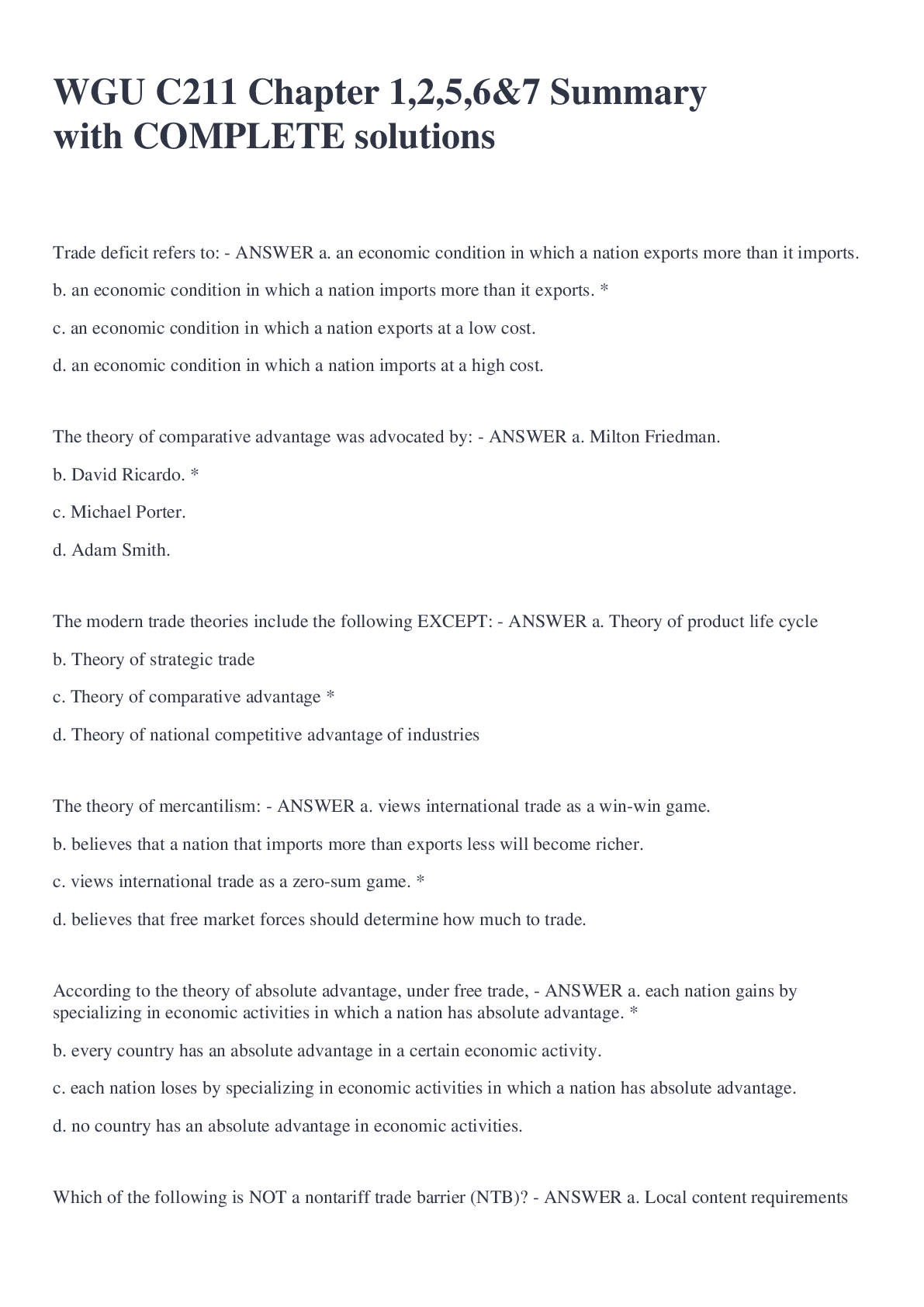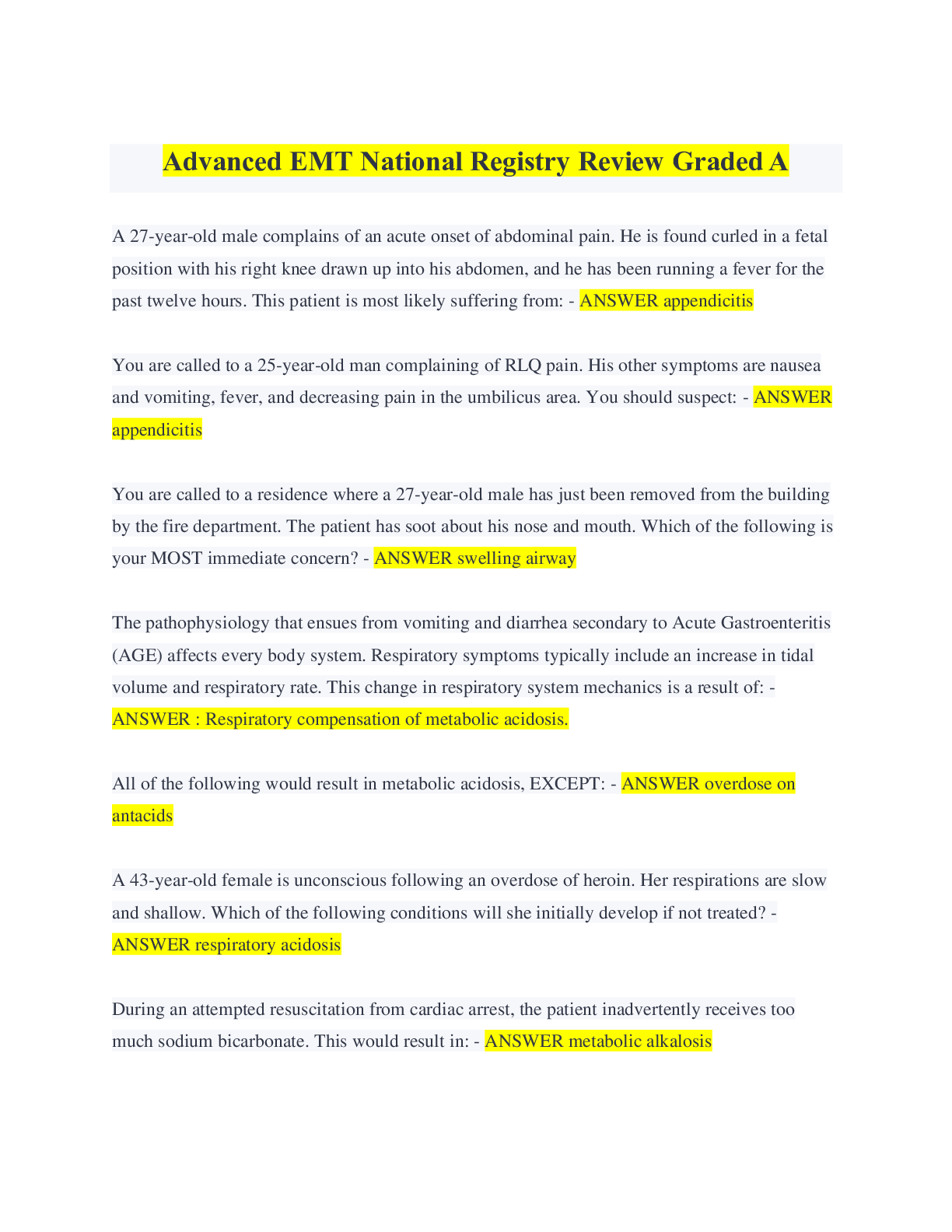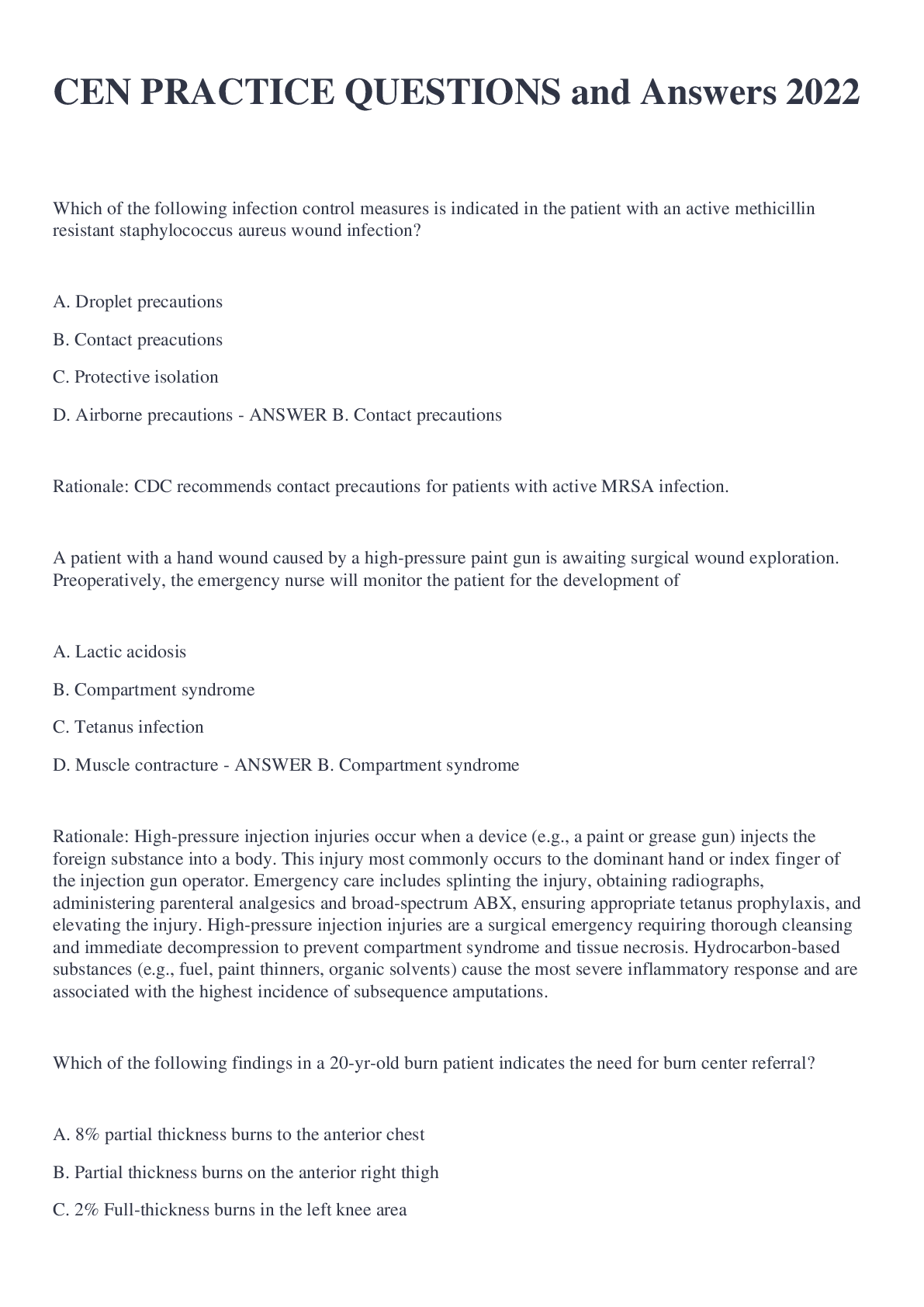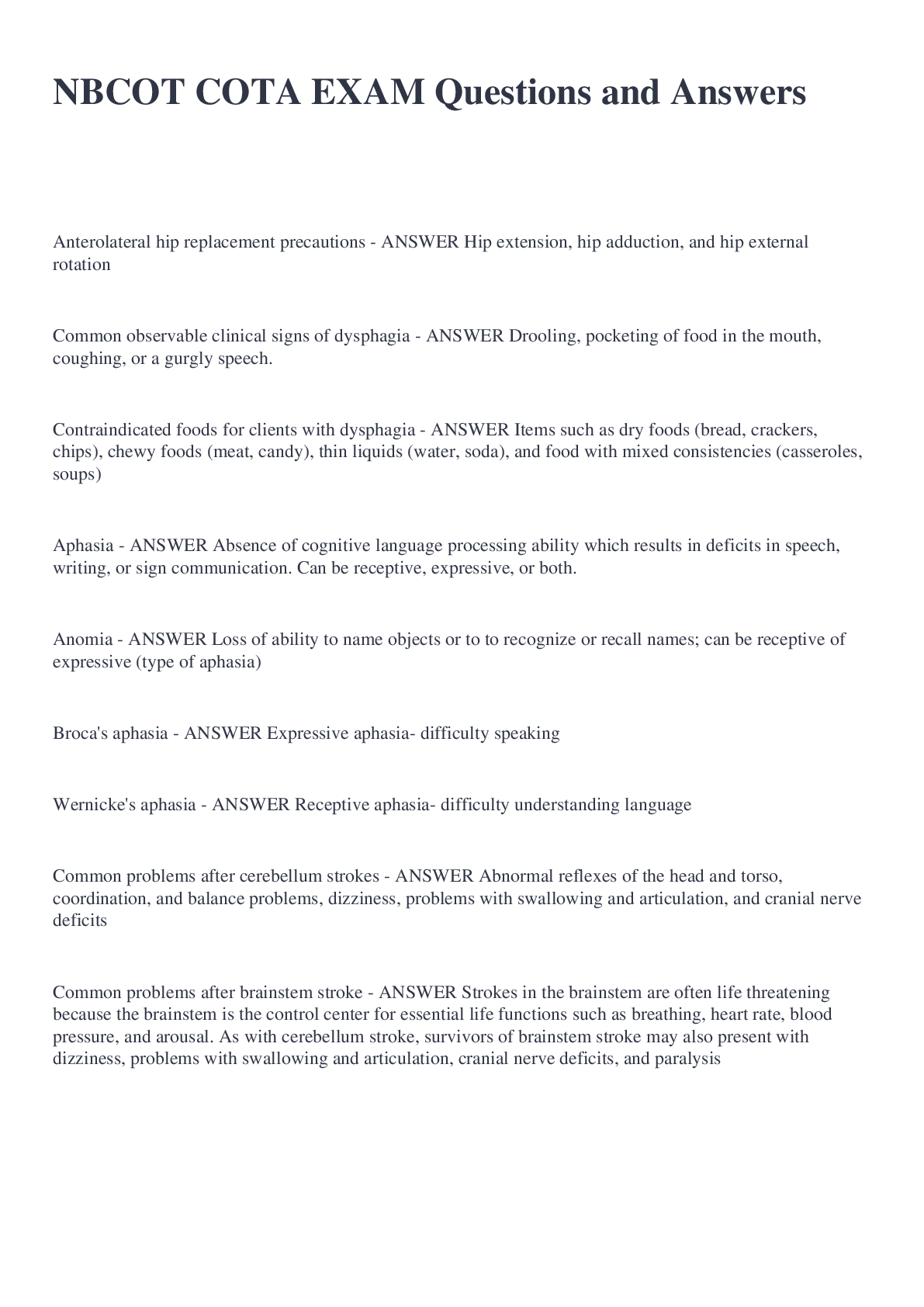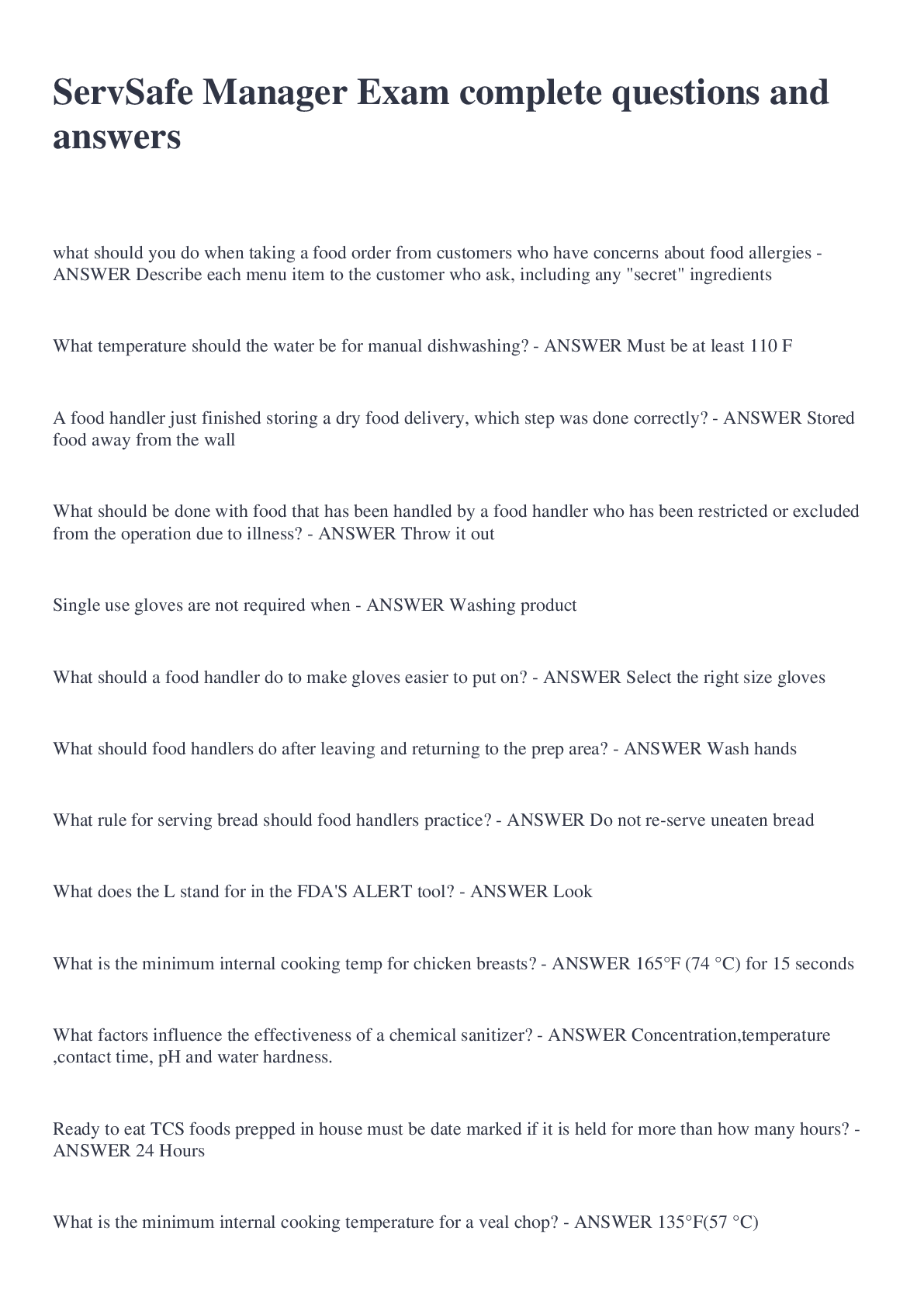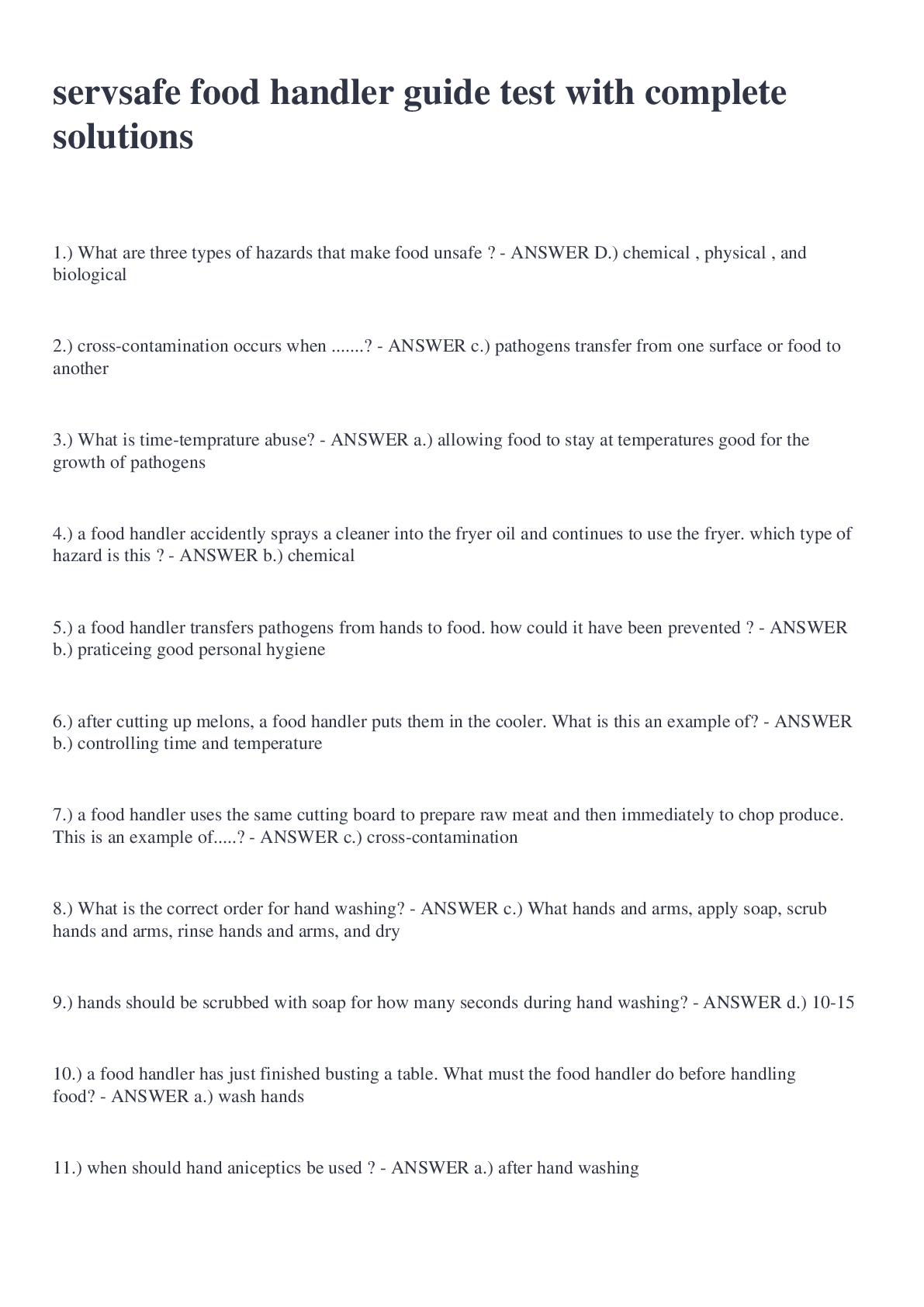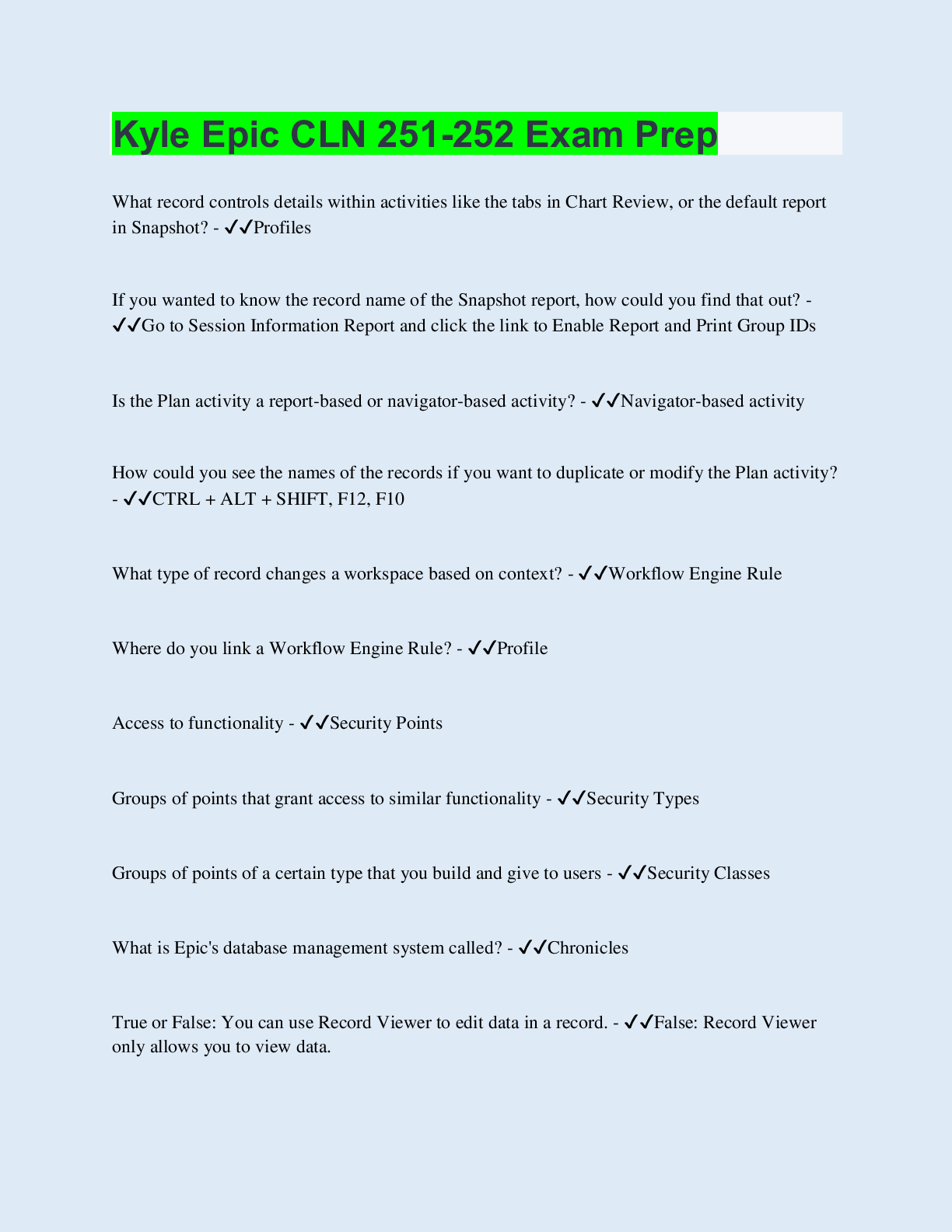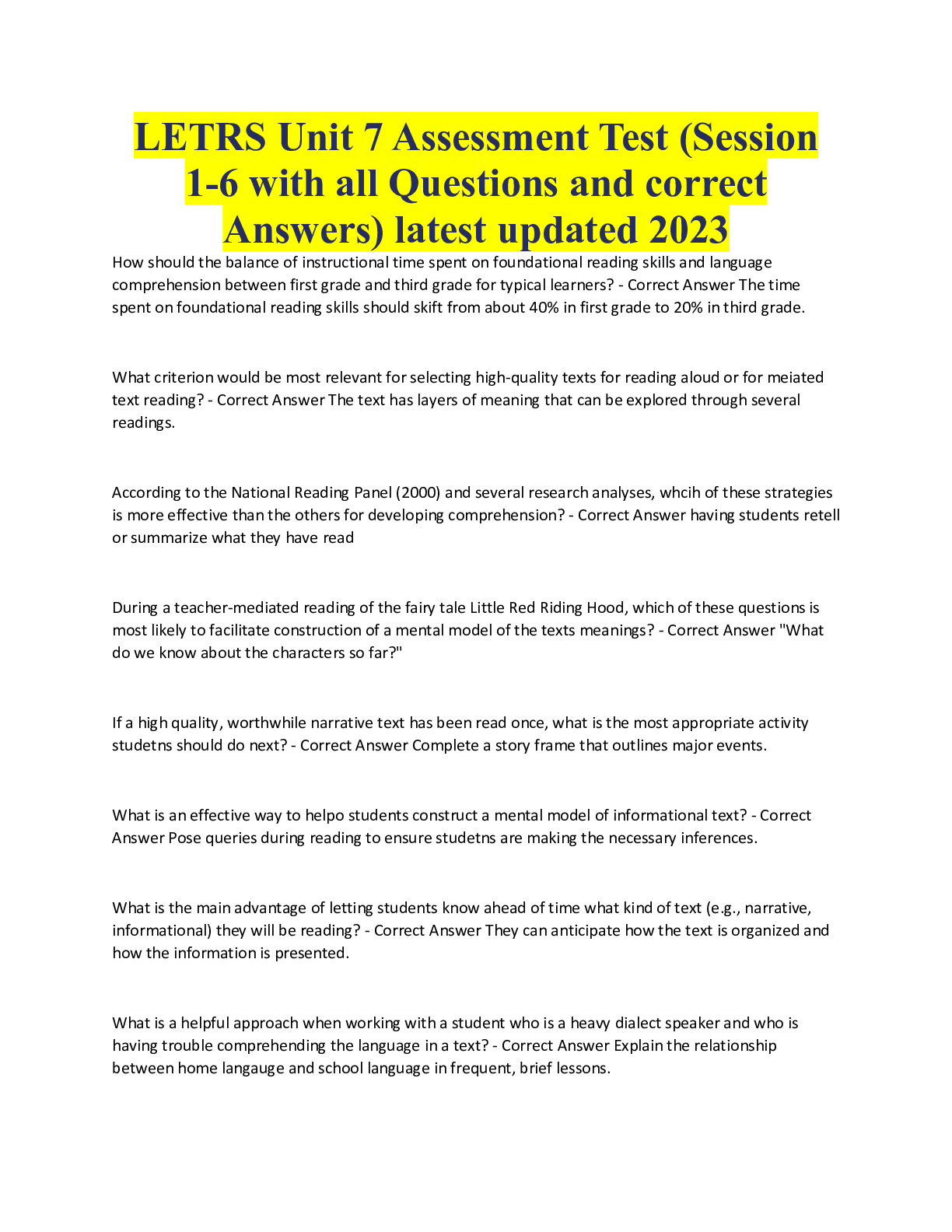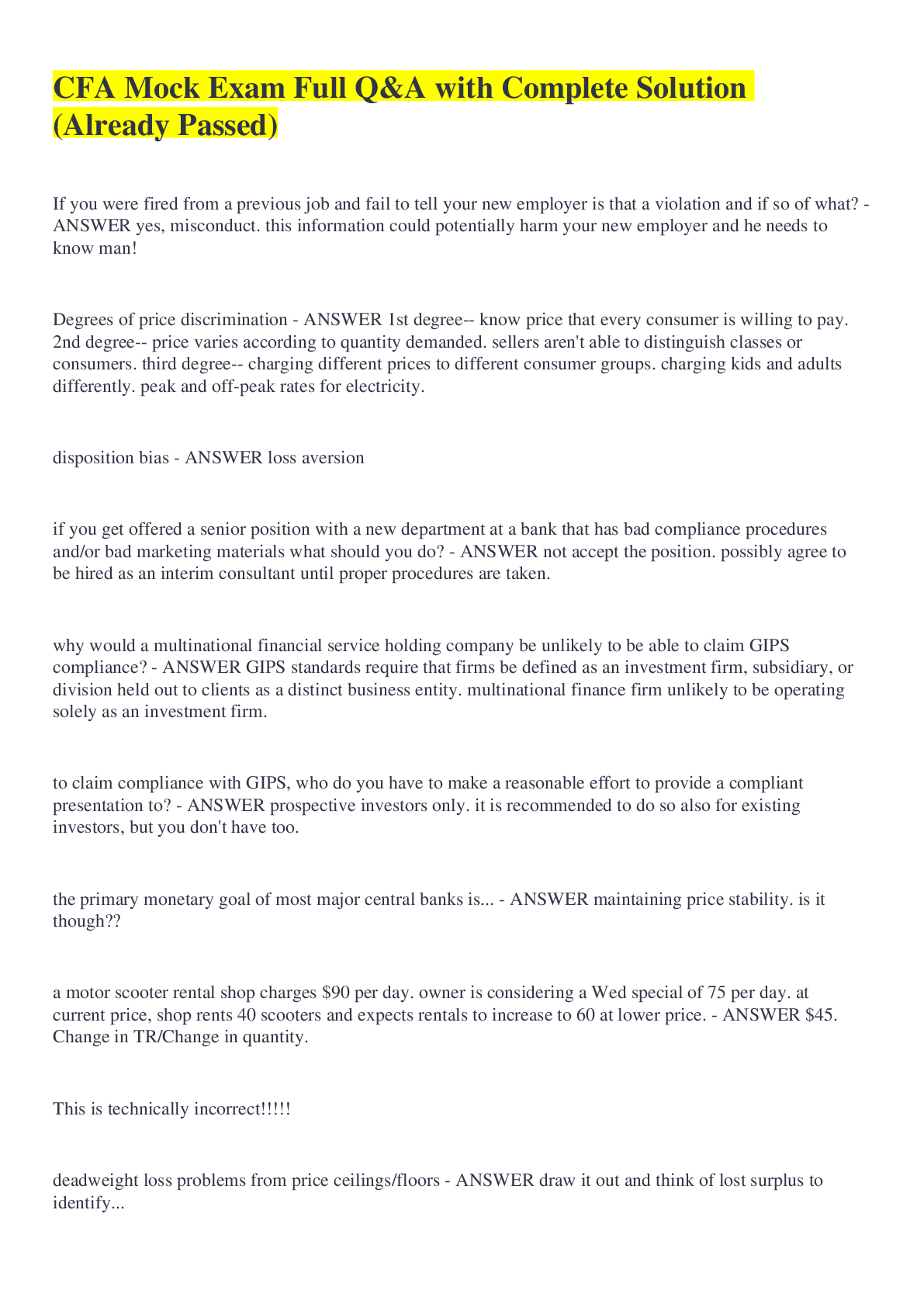History > EXAM > APUSH Units 6-11 Exam Study Guide with Comprehensive Solution (Already Passed) (All)
APUSH Units 6-11 Exam Study Guide with Comprehensive Solution (Already Passed)
Document Content and Description Below
information age, Microsoft, Internet - ANSWER Following WWII, the rise of International Business Machines (IBM) symbolized yet another momentous transformation, to the fast-paced "information age," wh... en the storing, organizing, and processing of data became an industry in its own right. By the century's end the rapid emergence of Microsoft Corporation and the phenomenal growth of the Internet heralded an explosive communications revolution. Americans now rocketed down the "information superhighway" toward the uncharted terrain of an electronic global village, where traditional geographic, social, and political boundaries could be vaulted with the tap of a keypad. In the blink of an eye, ordinary citizens could gain access to info once available only to privileged elites with vast libraries or expert staffs at disposal. A "dot-com" explosion of new commercial ventures quickly expanded the market (and the stock-market stakes) for entrepreneurs leading the way in making Internet a twenty-first-century, electronic mall, library, and entertainment center rolled into one. outsourcing of American jobs - ANSWER But the very speed and efficiency of the new communications tools threatened to wipe out entire occupational categories. Postal carrier, travel agents, store clerks, bank tellers, stockbrokers, and all kinds of workers whose business it was to mediate between product and client might find themselves roadkill on the information superhighway. White-collar jobs in financial services and high-tech engineering cold now be outsourced to countries such as Ireland and India, where employees could help keep a company's global circuits firing 24 hrs/ day. stock market decline - ANSWER The high-tech economy also proved to be as prone to the boom and bust system as the old smokestack economy. In the spring of 2000, the stock market began its most precipitous slide since WWII. By the time the markets bottomed out in 2003, they had lost $6 trillion in value. The boom of the late 1990s turned out to be, as one observer put it, the "Dot.con" Investors had scooped up shares in fledgling firms that proved unable to turn a profit, and stock prices imploded accordingly once the bubble burst. Millions of Americans watched aghast as their pension plans shrank by a third or more. Recent retirees scrambled back into the job market. Human Genome Project - ANSWER When scientists first unlocked the secrets of molecular genetic structure in the 1950's, the road lay open to breeding new strains of high-yield, pest -- and weather -- resistant crops; to curing hereditary diseases; and also, unfortunately, to unleashing genetic mutations that might threaten the fragile balance of the biosphere in which humankind was delicately suspended. The Human Genome Project established the DNA sequencing of the thirty thousand human genes, pointing the way to radical new medial therapies -- and to profits for bioengineering firms. Startling breakthroughs in the cloning of animals raised thorny questions about the legitimacy of applying cloning techniques to human reproduction. Research into human stem cells held out the promise of cures for afflictions like Parkinson's or Alzheimer's. But the Bush admin shared the concern of certain religious groups that harvesting stem cells involved the destruction of human life in embryonic form. Bush therefore limited government funding for stem cell research, as Americans struggled with the ethical implications of their vast new technological advances. Affluence and Inequality - ANSWER America's people were still an affluent people at the beginning of the 21st century, with even their poorest (below the government's poverty line) having a better standard of living than two-thirds of the rest of humankind. But Americans were no longer the world's wealthiest people, as they had been in the quarter-century after WWII. The gap between the rich and the poor began to widen in the 1980s and widened further thereafter. The Welfare Reform Bill of 1996, restricting access to social services and requiring able-bodied welfare recipients to find work, weakened the financial footing of many impoverished families still. The income of the rich was larger, and the poor usually did not get medical insurance. The tax and fiscal policies of Reagan and Bush (father and son) presidencies, which favored the wealthy, could be blamed for this, but other more important causes would be intensifying global economic competition; the shrinkage in high-paying manufacturing jobs for semiskilled and unskilled workers; the greater economic rewards commanded by educated workers in high-tech industries; decline of unions; the growth of part-time and temporary work; the rising tide of relatively low-skill immigrants; and the increasing tendency of educated men and women to marry one another and both work, creating household with very high incomes. Educational opportunities also had a way of perpetuating inequality, starting with the underfunding of many schools in poor and urban areas and the soaring cost of higher education. Feminist Revolution - ANSWER Women started in the 20th century making up 20% of all workers, but by the 1990's they made up 1/2. The majority of working-age women held jobs outside of the home. In 1950 nearly 90% of women with children did not work for pay, but by half a century later women with children as young as 1 years old were wage earners. Beginning in the 1960s, many all-male colleges and military academies opened their doors to women. However, women were still earning less than men in low-prestige, low-paying occupations (the "pink ghetto"). Occupational segregation was mostly due to the fact that women were far more likely than men to interrupt their careers to bear and raise children, and they even choose less demanding career paths to allow for fulfilling those traditional roles. More women than men voted Democratic, a party seen as willing to favor gov. support for health and child care, education, and job equality, as well as being more vigilant to protect abortion rights. More men started to share women's rolls as gender rolls became more mixed. divorce; unmarried mothers - ANSWER By 1990s one out of every two marriages ended in divorce. Seven times more children were affected by divorce than at the beginning of the century. The proportion of adults living alone tripled in the four decades after 1950, and by the 1990s nearly 1/3 of women aged 25 to 29 had never married. In the 1960's, 5% of all births were to unmarried women, but three decades later one out of four white babies, one out of three Latino babies, and two out of three African American babies were born to single mothers. Every fourth child in America was growing up in a household that lacked two parents. aging population and Social Security problems - ANSWER A person born at the dawn of the century could expect to live less than fifty years, whereas someone born in 2000 could anticipate a life span of seventy-seven years. Miraculous medical advances, including antibiotics and a vaccine against polio, lengthened and strengthened lives. Longer lives spelled more older people. This aging of the population raised a host of political, social, and economic questions. Elderly people formed a potent electoral bloc that aggressively lobbied for gov. favors and achieved real gains for senior citizens. The growth in medical payments for the old far outstripped the growth of educational expenditures for the young, with corresponding consequences for the social and economic situations of both populations. Benefits for senior citizens strained the Social Security System, established in 1935 to provide income retired workers. When Social Security began, most workers continued to toil after age 65. By the end of the century most of the elderly relied on Social Security checks for their living expenses. The payments of current workers into the Social Security system funded the benefits to the current generation of retirees. By the time the new century opened, those benefits had risen so high, and the ratio of active workers to retirees had dropped so low, that drastic adjustments were necessary. Mexican immigrants, "reconquista" - ANSWER Immigrants typically left countries where populations were growing rapidly and where agricultural and industrial revolutions were shaking people loose from old habits of life. And they came to America in search of jobs and economic opportunity. Mexican migrants especially flowed to the Southwest. By the turn of the century Latinos made up made up nearly 1/3 of the pop. in Texas, Arizona, and California, and 40% in New Mexico -- amounting to a demographic reconquista of the lands lost by Mexico in the war of 1846. Mexican Americans, because of their heavy concentration, seemed like they would be able to create a truly bicultural zone in the booming southwestern states. Latinos (Chicanos, Puerto Ricans, Cubans, others) - ANSWER Latinos, among the fastest-growing segments of the US population, include Puerto Ricans, frequent voyagers between their native land and northeastern cities; Cubans, many of them refugees form the communist dictatorship of Fidel Castro, concentrated in Miami and southern Florida; and Central Americans, fleeing the ravages of civil war in Nicaragua and EL Salvador. The US was home to 26 million Chicanos (Mexican Americans), 3 million Puerto Ricans, 1 million Cubans. They elected mayors of Miami, Denver, and San Antonio. add? United Farm Workers, Cesar Chavez (migrant workers) - ANSWER After a few years of struggle, the United Farm Workers Organizing Committee (UFWOC), headed by the soft-spoken and charismatic Cesar Chavez, succeeded in improving working conditions for the mostly Chicano "stoop laborers" who followed the cycle of planting and harvesting across the American West. add? Asian Americans - ANSWER CHECK HERE PAGE 1026 Asian Americans also made great strides since by the 1980's they were America's fastest-growing minority, and their numbers reached nearly 12 million by 2002. Once feared and hated as the yellow peril and consigned to the most menial degrading jobs, citizens of Asian ancestry were now counted among the most prosperous Americans with the typical Asian household holding nearly 25% greater than that of the typical white household in 2003. Native-Americans (legalized gambling) - ANSWER Indians numbered some 2.4 million in 2000 the census. Half of them had left their reservations to live in cities. Meanwhile, unemployment and alcoholism had blighted reservation life. Many tribes took advantage of their special legal status as independent nations by opening bingo halls and gambling casinos for the general public on reservation lands, but the cycle of discrimination and poverty proved hard to break. urban crime - ANSWER Crime was the great scourge of urban life. The rate of violent crimes committed in cities reaching all-time high in the drug-infested 1980s and then leveled off in the early 1990s. The number of violent crimes even began to decline substantially in many areas after 1995. Nevertheless, murders, robberies, and rapes remained shockingly common not only in cities but also in suburbs and rural areas. The US imprisoned a larger fraction of its citizens than almost any other country in the world, and the some desperate citizens resorted to armed vigilante tactics to protect themselves. gated communities - ANSWER The nation's brief "urban age" lasted little more than seven decades after 1920, and with its passing many observers saw a new fragmentation and isolation in American life. Some affluent suburban neighborhoods walled themselves off behind elaborate security systems in "gated communities," making it harder, perhaps, to sustain a sense of a larger and inclusive national community. suburbs - ANSWER By the first decade of the 21st century, the suburban rings around big cities such as NY< Chicago, Houston, and Washington, DC., were becoming more racially and ethnically diverse, though individual schools and towns were often homogenous. Suburbs grew fastest in the West and Southwest. In the outer orbits of LA, San Diego, Las Vegas, and Phoenix, builders of roads, water mains, and schools could barely keep up with the new towns sprouting across the hardscrabble landscapes. add? movement to the South and West - ANSWER A momentous shift of the American population was underway, as inhabitants from the the Northeast and Rustbelt Midwest moved southward and westward to job opportunities and the sun. The Great Plains, where 60% of all counties were losing pop. as the 20th century ended, were facing the sharpest decline, hollowing out the traditional American heartland. Los Angeles racial riots - ANSWER Racial and ethnic tension exacerbated problems in American cities. These stresses were especially evident in Los Angeles which was a magnet for minorities, especially immigrants from Asia and Latin America. When in 1992 a mostly white jury exonerated white Los Angeles police officers who had been videotaped ferociously beating a black suspect, the minority neighborhoods of South Central Los Angeles erupted in rage. Arson and looting laid waste entire city blocks, and scores of people were killed. Some attacked Asian shopkeepers, who in turn formed armed patrols to protect themselves. The riots showed the African American skepticism about the American system of justice. "Eurocentric" curriculum - ANSWER The nation's classrooms became battlegrounds for the debate over America's commitment to pluralism. Multiculturalists attacked the traditional curriculum as "Eurocentric" and advocated greater focus on the achievements of African Americans, Latinos, Asian Americans, and Native Americans. In response, critics charged that too much stress on ethnic difference wold come at the expense of national cohesion and an appreciation of common American values. new trends in art and literature - ANSWER Americans in the early 21st century read more, listened to more music, and were better educated than ever before. Authors from racial minorities were on the rise esp. from the West. Authors wrote about the small-town west, the end of the cattle-drive era, working class life of the Pacific Northwest, recreation of frontier history, interracial anxiety and affection in WWII-era Pacific Northwest, and of boyhood in Montana. African authors and artists were increasing their mark. Playwrights retold the history of black Americans in the 20th century esp. the psychic cost of the northward movement, musicals focused on the question of black identity and the life of a New Orleans jazzman. Some told of the life of a slave owning family. Native Americans wrote portrayals of Indian life or ancestors. Asian Americans wrote plays, novels, and essays which imaginatively reconstructed the obscure lives of earliest Chinese immigrants or told a humorous tale of suburban family relationships that was not uncommon for 2nd generation Asian Americans or explore the sometimes painful relationship between immigrant Indian parents and their American-born children. New York became the art capital of the world after WWII with artists experimenting with abstract expressionism, flinging paint on huge flats stretched on his studio floor. They tried to create action paintings that expressed individuality and made viewer a creative participant in defining the painting's meaning. These art pieces often used common things like cans and paper clippings. CHECK! Page 1030 corporate scandals, Enron, WorldCom - ANSWER As job opportunities shrank in some of the nation's regions and expanded in others, as jobs shifted to cheaper labor markets abroad, and giant corporations like Enron and WorldCom collapsed through corporate scandal, many Americans began to fear their economy as a treacherous landscape even as it offered some of them astounding prosperity. add? Alaskan oil spill; Exxon Valdez - ANSWER The planet was being drained of oil, and disastrous accidents like the grounding and subsequent oil spill of the giant tanker "Exxon Valdez" in 1989 in Alaska's pristine Prince William Sound demonstrated the ecological risk of oil exploration and transportation at sea. add? Bill Clinton, New Democrat, Al Gore - ANSWER In a bruising round of primary elections, Governor William Jefferson Clinton of Arkansas weathered blistering accusations of womanizing and draft evasion to emerge as his party's standard-bearer (in the 1992 presidential elections). Breaking the tradition of a "balanced ticket," he selected a fellow forty-something southern white male Protestant moderate, Senator Albert Gore of Tennessee, as his vice-presidential running mate. Clinton claimed to be a "new" Democrat, chastened by the party's long exile in the political wilderness. With other centrist Democrats, he had formed the Democratic Leadership Council to point the party away from its traditional antibusiness, dovish, champion-of-the-underdog orientation and toward a pro-growth, strong defense, and anticrime policies. Clinton won the election with 370 electoral votes. ADD? Ross Perot (Reform Party) - ANSWER Reflecting the pervasive economic unease and the virulence of the throw-the-bums-out national mood, nearly 20% of voters cast their ballots for independent presidential candidate H. Ross Perot. add? women appointed to government positions - ANSWER Women figured prominently in President Clinton's cabinet, including the first female attorney general, Janet Reno, and former University of Wisconsin president Donna Shalala, who became secretary of health and human services. Vowing to shape a government that "looked like America," Clinton appointed several ethnic and racial minority members to his cabinet. He also seized the opportunity to nominate Ruth Bader Ginsberg to the Supreme Court, where she joined Sandra Day O'Conner to make a pair of women justices. ban on gays in the military; "don't ask don't tell" - ANSWER In one of his first initiatives on taking office, Clinton stirred a hornet's nest of controversy by advocating an end to the ban on gays and lesbians in the armed services. Confronted with fierce opposition, the president finally had to settle for a "don't ask, don't tell" policy that quietly accepted gay and lesbian soldiers and sailors without officially acknowledging their presence in the military. Hillary Rodham Clinton; health care task force - ANSWER In a dramatic but personally and politically risky move, the president appointed his wife, nationally prominent lawyer and children's advocate Hillary Rodham Clinton, as the director of the task force charged with redesigning the medical-service industry. Their stupefyingly complicated plan was dead on arrival when it was presented to Congress in Oct 1993. The First Lady was doused with a torrent of abuse, although she eventually rehabilitated herself sufficiently to win election as a US senator from NY in 2000 -- the first First Lady ever to hold elective office. deficit reduction, federal government surplus - ANSWER Clinton had better luck with a deficit-reduction bill in 1993, which combined with an increasingly buoyant economy by 1996 to shrink the federal deficit to its lowest level in more than a decade. By 1998 Clinton's policies seemed to have caged the ravenous deficit monster, as Congress argued over the unfamiliar question of how to manage federal budget surpluses. Brady Bill - ANSWER The president also induced Congress in 1993 to pass a gun-control law, the "Brady Bill," named for presidential aide James Brady, who had been wounded and disabled by gunfire in the assassination attempt on President Ronald Reagan in 1981. In July 1994, Clinton made further progress against the national plague of firearms when he persuaded Congress to pass a $30 billion anticrime bill, which contained a ban on several types of assault weapons. Oklahoma City bombing - ANSWER A huge explosion destroyed a federal office building in Oklahoma City in 1995, taking 168 lives, presumably in retribution for a 1993 standoff in Waco, Texas, between federal agents and a fundamentalist sect known as the Branch Davidians. Branch Davidian siege - ANSWER The Oklahoma City bombing was presumably in retribution for a 1993 standoff in Waco, Texas, between federal agents and a fundamentalist sect known as the Branch Davidians. The showdown ended in the destruction of the sect's compound and the deaths of many Branch Davidians, including women and children. These episodes brought to light a lurid and secretive underground of paramilitary private "militias" composed of alienated citizens armed to the teeth and ultra-suspicious of all government. Columbine high school shootings - ANSWER On an April morning in 1999, two students at Columbine High School in Littleton, Colorado, killed twelve fellow students and a teacher. Debate flared over the origins of school violence. Some observers targeted the violence portrayed in movies, TV shows, and video games; others pointed to the failings of parents. But the culprit that attracted the most sustained political attention was guns -- their abundance and accessibility, esp. in suburban and rural communities. add? Newt Gingrich "Contract with America" - ANSWER (1994) Led by outspoken Georgia representative Newt Gingrich, Republicans offered voters a "Contract with America" that promised an all-out assault on budget deficits and radical reductions in welfare programs. Their campaign succeeded fabulously, as a right-wing tornado roared across the land in the 1994 congressional elections. Every incumbent Republican gubernatorial, senatorial, and congressional candidate was reelected. Republicans also picked up eleven new governorships, eight seats in the Senate, and 53 seats in the House (where Gingrich became speaker), giving them control of both chambers of the federal Congress for the first time in 40 years. add? unfunded mandates - ANSWER But if President Clinton had overplayed his mandate for liberal reform in 1993, the congressional Republicans now proceeded to overplay their mandate for conservative retrenchment. The new Republican majority did legislate one long-standing conservative goal when they restricted "unfunded mandates" -- federal laws that imposed new obligations on state and local governments without providing revenues. add? Welfare Reform Bill - ANSWER In 1996 the new Congress achieved a major conservative victory when it compelled a reluctant Clinton to sign the Welfare Reform Bill, which made deep cuts in welfare grants and required able-bodied welfare recipients to find employment. The new welfare law also tightly restricted welfare benefits for legal and illegal immigrants alike, reflecting a rising tide of anti-immigrant sentiment as the numbers of newcomers climbed toward an all-time high. Old-line liberal Democrats howled with pain at the president's alleged betrayal of his party's heritage, and some prominent. admin members resigned in protest against his decision to sign the welfare bill. But Clinton's acceptance of the welfare reform package was part of his shrewd political strategy of accommodating the electorate's conservative mood by moving to his right. Clinton reelection 1996 - ANSWER As the 1996 election approached, the Republicans chose Kansas senator Robert Dole as their presidential candidate. A decorated WWII veteran, Dole ran a listless campaign. Clinton, buoyed by a healthy economy and by his artful trimming to the conservative wind, breezed to an easy victory. Clinton won 379 electoral votes, Dole only 159. But Republicans remained in control of Congress. North American Free Trade Agreement (NAFTA) - ANSWER During his first term, Clinton had displayed political courage by supporting the North American Free Trade Agreement (NAFTA), creating in 1993 a free-trade zone encompassing Mexico, Canada, and the US. In doing so, he reversed his own stand in the 1992 election campaign and bucked the opposition of protectionists in his own party, esp. labor leaders fearful of losing jobs to low-wage Mexican workers. World Trade Organization (WTO) and protesters - ANSWER Clinton took another step in 1994 toward a global free-trade system when he vigorously promoted the creation of the World Trade Organization (WTO), the successor to the General Agreement on Tariffs and Trade (GATT) and a cherished goal of free-trade advocates since the end of WWII. Simmering discontent over trade policy boiled over in 1999 when Clinton hosted the meeting of the WTO in Seattle. The city's streets filled with protesters railing against what they viewed as the human and environmental costs of economic "globalization." Trade talks fizzled in Seattle, with Clinton taking a hefty share of the blame. campaign finance reform - ANSWER Campaign finance reform, long smoldering as a potential issue, suddenly flared up after the 1996 presidential contest. Congressional investigators revealed that the Clinton campaign had received funds from many improper sources, including contributors who paid to stay overnight in the White House and foreigners who were legally prohibited from giving to American candidates. But Republicans and Democrats alike had reason to avoid reform. Both parties had grown dependent on vast sums to finance television ads for the candidates. But within the ranks of both parties, a few mavericks proposed to eliminate the corrupting influence of big donors. Senator John McCain from Arizona made campaign finance reform a centerpiece of his surprisingly strong, though ultimately unsuccessful, bid for Republican presidential nomination in the 2000 campaign. Somalia, Rwanda, China (summarize issues) - ANSWER Clinton followed his predecessor's lead in dispatching American troops as part of a peacekeeping mission to Somalia and reinforced US contingent after Somalia revels killed more than a dozen Americans in late 1993. But in March 1994, the president quietly withdrew the American units, without having accomplished any clearly defined goal. Burned in Somalia, Washington stood on the sidelines in 1995 when catastrophic ethnic violence in central African country of Rwanda resulted in the deaths of half a million people. Clinton also struggled to define a policy with respect to China, which was rapidly emerging as an economic and political powerhouse. Candidate Clinton had denounced George Bush in 1992 for not imposing economic sanctions on China as punishment for Beijing's wretched record of human rights abuses. But China's economic importance to the US did not permit Washington the luxury of taking the high road on human rights. Clinton soon soft-pedaled his criticism of the Beijing regime and instead began seeking improved trade relations with that robustly industrializing country and potential market bonanza. change? the Balkans (former Yugoslavia); use of NATO forces - ANSWER Clinton's approach to the tormented Balkans in southeastern Europe showed a similar initial hesitation, followed eventually by firm leadership. In the former Yugoslavia, as vicious ethnic conflict raged through Bosnia, the Washington government dithered until finally deciding to commit American troops to a NATO peacekeeping contingent in late 1995. Deadlines for removing the troops were postponed and then finally abandoned altogether as it became clear that they were the only force capable of preventing new hostilities. NATO's expansion to include the new member states of Poland, Hungary, and the Czech Republic in 1997, and its continuing presence in Bosnia, failed to pacify the Balkans completely. When Serbian president Milosevic in 1999 unleashed a new round of "ethnic cleansing" in the region, this time against ethnic Albanians in the province of Kosovo, US-led NATO forces launched an air war against Serbia. The bombing campaign initially failed to stop ethnic terror, as refugees flooded into neighboring countries, but it eventually forced Milosevic to accept a NATO peacekeeping force on the ground in Kosovo. add? page 995 Whitewater, Monica Lewinsky scandal - ANSWER Allegations of wrongdoing, reaching back to his pre-presidential days in Arkansas, included a failed real estate investment known as Whitewater Land Corporation. The Clintons' involvement in that deal prompted the appointment of a federal special prosecutor to investigate -- though an indictment for Whitewater wrongdoing never materialized. All previous scandals were overshadowed when it was revealed in Jan 1998 that Clinton had engaged in a sexual affair with a young White House intern, Monica Lewinsky, and then lied about it when he testified under oath in another woman's civil lawsuit accusing him of sexual harassment. special prosecutor Kenneth Starr - ANSWER The accusation that Clinton had lied under oath presented stunning windfall to the special prosecutor, Kenneth Starr. Clinton, now suddenly caught in legal and political trap, issued repeated denials of involvement with "that woman," Ms. Lewinsky. But he was finally forced to make the humiliating admission that he had an "inappropriate relationship" with her. In Sept 1998 Starr accordingly presented to the House of Representatives a stinging report, including lurid sexual details, charging Clinton with eleven possible grounds for impeachment, all related to the Lewinsky matter. House of Representatives articles of impeachment - ANSWER The House quickly cranked up the rusty machinery of impeachment. As an acrid partisan atmosphere enveloped the Capitol, House Republicans in Dec 1998 passed two articles of impeachment against the president: perjury before a grand jury and obstruction of justice. Crying foul, the Democratic minority charged that, however deplorable Clinton's personal misconduct, sexual transgressions did not rise to the level of "high crimes and misdemeanors" prescribed in the Constitution. The House Republican managers (prosecutors) of impeachment for the Senate trial replied that perjury and obstruction were grave public issues and that nothing less than the "rule of law" at stake. Senate impeachment trial (obstruction of justice, perjury) - ANSWER House Republicans passed two articles of impeachment against the president: perjury before a grand jury and obstruction of justice. In early 1999, for the first time in 130 years, the nation witnessed an impeachment proceeding in the US Senate. Dusting off ancient precedents from Andrew Johnson's trial, the one hundred senators solemnly heard arguments and evidence in the case, with Chief Justice William Rehnquist presiding. On the key obstruction of justice charge, five northeastern Republicans joined all 45 Democratic senators in voting not guilty. The fifty Republican votes for conviction fell far short of the constitutionally required two-thirds majority. The vote on the perjury charge was 45 guilty, 55 not guilty. Election of 2000, George W. Bush and Dick Cheney - ANSWER Clinton's loyal VP, Albert Gore, easily won the Democratic party's presidential nomination in 2000. He chose as his running mate Connecticut senator Joseph Lieberman, an outspoken critic of Clinton during the Lewinsky affair and the first Jew nominated to a national ticket by a majority party. The Republican nominee, George W. Bush, had catapulted to the party prominence on the strength of his status of the eldest son of former president George H. W. Bush and his popularity as a two-term governor of Texas. Bush chose Richard Cheney, former secretary of defense in the elder Bush's admin and a key planner in the Persian Gulf War in 1991, as his vice-presidential running mate. add? voting problems, Supreme Court involvement - ANSWER Pollsters and candidates alike predicted a close election, but they could not foresee that the result would be an epochal cliffhanger. When the Florida Supreme Court ordered a hand count of nearly sixty thousand ballots that the machines had failed to read, Republicans struck back on two fronts. The Republican-dominated Florida legislature moved to name a set or pro-Bush electors, regardless of the vote tabulating and re-tabulating then under way. In the Supreme Court the nine justices broke into a bare-knuckle judicial brawl. Five tumultuous weeks after election day, the presidential campaign of 2000 finally ended when the high court's five most conservative members ruled in Bush's favor. They reasoned that since neither Florida's legislature nor its courts had established a uniform standard for evaluating disputed ballots, the hand counts amounted to an unconstitutional breach of the 14th Amendment's equal protection clause. add? change? page 999 Bush domestic policies (summarize page 1000) - ANSWER As president, Bush soon proved to be more of a divider than a uniter, less a "compassionate conservative" than a crusading ideologue. Religious traditionalists cheered but liberals jeered when he withdrew American support from international health programs that sanctioned abortion, advocated federally financed faith-based social welfare initiatives, and sharply limited government-sponsored research on embryonic stem cells, which many scientists believed held the key to conquering diseases such as Parkinson's and Alzheimer's. He pleased corporate chieftains but angered environmentalists by challenging scientific findings on ground-water contamination and global warming, repudiating the Kyoto Treaty limiting greenhouse gas emissions, advocating new oil exploration in the Arctic National Wildlife Refuge on Alaska's ecologically fragile north coast, and allowing VP Cheney to hammer out his admin's energy policy in behind-closed-doors meetings with representatives of several giant oil companies. He pressed ahead with a tax cut of $1.3 trillion, turning the federal budget surpluses of the late 1990s into yawning deficits. red states, blue states - ANSWER These polarizing policies both reflected and deepened the cultural chasm that increasingly divided "red" from "blue" America (map p. 1001). The new president's initiatives proved to so divisive that a member of his own party, Vermont senator James Jeffords, severed his connection with the Republicans in May 2001, thereby briefly returning control of the Senate to the Democrats -- though they became the Senate minority party once again following the 2002 elections. September 11, 2001; Osama bin Laden; Al Qaeda - ANSWER On Sept 11, 2001, the long era of America's impregnable national security violently ended. Suicidal terrorists slammed two hijacked airliners, loaded with passengers and jet fuel, into the twin towers of NYC's World Trade Center. They flew a third plane into the military nerve center of the Pentagon, near DC, killing 189 people. Heroic passengers forced another hijacked aircraft to crash in rural Pennsylvania, killing all 44 aboard but depriving the terrorists of a fourth weapon of mass destruction. President Bush responded with a sober and stirring address to Congress nine days later. While emphasizing his respect for the Islamic religion and Muslim people, he identified the principal enemy as Osama bin Laden, head of a shadowy terrorist network known as Al Qaeda. A wealthy extremist exiled from his native Saudi Arabia, bin Laden was associated with earlier attacks on American embassies in East Africa and on a US Navy vessel in Yemen. Bin Laden was known to harbor venomous resentment toward the US for its economic embargo against Saddam Hussein's Iraq, its growing military presence in the Middle East, and its support for Israel's hostility toward Palestinian nationalism. Taliban rule in Afghanistan; U.S. troops - ANSWER Bin Laden had taken refuge in landlocked Afghanistan, ruled by Islamic fundamentalists called the Taliban. When the Taliban refused to hand over bin Laden, Bush ordered a massive military campaign against Afghanistan. Within three months American and Afghan rebel forces had overthrown the Taliban but failed to find bin Laden, and Americans continued to live in fear of future attacks. add? Patriot Act 2001; Department of Homeland Security - ANSWER In this anxious atmosphere, Congress in Oct 2001 rammed through the USA Patriot Act. The Act permitted extensive telephone and e-mail surveillance and authorized the detention and deportation of immigrants suspected of terrorism. Just over a year later, Congress created a new cabinet-level Department of Homeland Security to protect the nation's borders and ferret out potential attackers. Guantanamo military base and prison - ANSWER The Bush admin further called for trying suspected terrorists before military tribunals, where the usual rules of evidence and procedure did not apply. As hundreds of Taliban fighters captured in Afghanistan languished in legal limbo on the American military base at Guantanamo, Cuba, public-opinion polls showed Americans sharply divided on whether the terrorist threat fully warranted such drastic encroachments of America's venerable tradition of protecting civil liberties. Axis of Evil: Iraq, Iran, North Korea - ANSWER In Jan 2002, just weeks after the Sept 11 attacks, Bush claimed that Iraq, along with Iran and North Korea, constituted an "axis of evil" that gravely menaced American security. Iran and North Korea were both known to be pursuing nuclear weapons programs, and Iran had long supported terrorist operations in the Middle East. But the Iraqi tyrant, Saddam Hussein, defeated but not destroyed by Bush's father in 1991, became the principal object of the new president's wrath. Bush was brashly determined to break with long-standing American traditions and wage a preemptive war against Iraq -- and to go it alone if necessary. Iraq; weapons of mass destruction (WMD) - ANSWER Itching for a fight, and egged on by hawkish VP Cheney and other "neoconservative" advisers, Bush accused the Iraqi regime of all manner of wrongdoing: oppressing its own people; frustrating the weapons inspectors (avoiding the weapon inspections); developing nuclear, chemical, and biological weapons of mass destruction (WMD); and supporting terrorist organizations like Al Qaeda. add? 2003 invasion of Iraq; arrest of Saddam Hussein - ANSWER Heavy majorities in both houses of Congress passed a resolution in Oct 2002 authorizing the president to employ armed force to defend against Iraqi threats to America's national security and to enforce UN resolutions regarding Iraq. A month later the UN Security Council voted unanimously to give Iraq "a final opportunity to comply with its disarmament obligations." UN weapons inspectors returned to Iraq, and Saddam once again harassed and blocked them. No WMDs were found. The UN declined to authorize the use of force to compel compliance. In this tense and confusing atmosphere, Bush, with Britain as his only major ally, launched the long-anticipated invasion of Iraq on March 19, 2003. Saddam Hussein's vaunted military machine collapsed almost immediately. In less than a month, Baghdad had fallen and Saddam had been driven from power and hounded into hiding. He was found and arrested some nine months later. further violence in Iraq - ANSWER Contrary to rosy predictions that the Iraqi people would welcome the Americans as liberators and that democracy would sweetly blossom, Iraq became a seething cauldron of apparently endless violence. Iraqi factions jockeyed murderously for political position in the post-Saddam era. Iraqi insurgents, aided by militants drawn from other Islamic nations, repeatedly attacked American troops, killing more US soldiers during the occupation (nearly 1,200 by 2004) than during the invasion itself (139). Revelations in April 2004 about American abuse of Iraqi prisoners in Baghdad's notorious Abu Ghraib prison further inflamed anti-American sentiment in Iraq and beyond. Once a model democracy and an inspiration to the world, the US was now reviled in many quarters as just another arrogant imperialistic power. add? page 1006 gay marriage - ANSWER Acrimonious controversies over the rights of gays and lesbians to marry flared up in San Francisco, Massachusetts, and Portland, Oregon in 2004. court modification of affirmative action - ANSWER Affirmative action continued to agitate the American people. Most African Americans and other minorities hailed it as a just and necessary antidote to centuries of oppression. Many other Americans countercharged that affirmative action amounted to an unjustifiable violation of the Constitution's protection of equality before the law. The Supreme Court appeared to split the difference between these two positions in the twin cases of "Gratz v. Bollinger" and "Grutter v. Bollinger" in 2003. In the first case, the Court declared unconstitutional a numerical formula for admitting minority undergraduate students to U of M. In the second, it allowed to stand a more flexible, individually based minority admissions procedure for the Michigan law school, even while registering its unease with its own opinion by declaring, "We expect that 25 years from now, the use of racial preferences will no longer be necessary." No Child Left Behind - ANSWER Pursuant to his campaign promise to end "the soft bigotry of low expectations," Bush championed the No Child Left Behind Act in 2002, which mandated sanctions against schools that failed to meet federal performance standards. Election 2004; Bush v. Kerry - ANSWER After a bruising round of primary elections, the Democrats chose as their standard-bearer the Mass. Senator John F. Kerry. Kerry was challenged on the campaign trail to defend the many seemingly contradictory positions he had taken during his 18-year Senate career. He stumbled badly when he said that he had actually voted for a major military spending bill before he voted against it. Such a reversal is normal procedure as bills make their way through the tortuous legislative process, but amid the sound-bite hubbub of a fast-paced presidential campaign, Kerry's statement seemed to ratify Republican accusations that he was a waffling flip-flopper. Bush, in contrast, hammered home the simple message that he was an unflinching, God-fearing, conservative defender of traditional moral values and an implacable for America's enemies. Bush won with 286 electoral votes to 252. add? page 1008 conservatives and the New Right (list social concerns) - ANSWER Certainly the 1980s were a new day for America's conservative right. The conservative cause drew added strength from the emergence of a "New Right" movement, partly in response to the countercultural protests of the 1960s. Spearheading the New Right were evangelical Christian groups such as the Moral Majority, dedicated believers who enjoyed startling success as political fund-raisers and organizers. New Right activists denounced abortion, pornography, homosexuality, feminism, and esp. affirmative action. The championed prayer in the schools and tougher penalties for criminals. Together the Old and New Right added up to a powerful political combination, devoted to changing the very character of American society. Ronald Reagan (summarize his career) - ANSWER An actor-turned-politician, Reagan enjoyed enormous popularity with his crooked grin and aw-shucks manner. Reagan got his start in life in the depressed 1930s as a sports announcer for an Iowa radio station. Good looks and a way with words landed him acting jobs in Hollywood, where he became a B-grade star in the 1940s (he played in the original "Million Dollar Baby"). He displayed a flair for politics as president of the Screen Actors Guild in the McCarthy era of the early 1950s, when he helped purge communists and other suspected "reds" from the film industry. In 1954 he became a spokesman for General Electric and began to abandon his New Deal-ish political views and increasingly to preach a conservative, antigovernment line. Reagan's growing skill at promoting the conservative cause inspired a group of wealthy California businessmen to help him launch his political career as governor of California from 1966 to 1974. He was the Republican presidential nominee in 1980. Carter's problems; Edward Kennedy - ANSWER By 1980 the Republican party was ready to challenge the Democrats' hold on the White House. Bedeviled abroad and becalmed at home, Jimmy Carter's administration struck many Americans as bungling and befuddled. Carter's inability to control double-digit inflation was esp. damaging. Frustrated critics bellyached loudly about the Georgian's alleged mismanagement of the nation's affairs. The liberal wing of the Democratic party found its champion in Senator Edward Kennedy of Massachusetts, the last survivor of the assassin-plagued Kennedy brothers. He and Carter slugged it out in a series of bruising primary elections, while delighted Republicans decorously proceeded to name Reagan their presidential nominee. In the end Kennedy's candidacy fell victim to the country's conservative mood. A battered Carter, his party divided and in disarray, was left to battle with Reagan. Election of 1980, Inauguration, Iran hostages released - ANSWER On election day the Republican Reagan rang up a spectacular victory, bagging over 51 percent of the popular vote, while 41 percent went to Carter and 7 percent to moderate independent candidate John Anderson. Equally startling, the Republicans gained control of the Senate for the first time in 25 years. Reagan's arrival in Washington was triumphal. The Iranians contributed to the festive mood by releasing the hostages on Reagan's Inauguration Day, January 20, 1981, after 444 days of captivity. smaller government - ANSWER The new president was devoted to fiscal fitness and a leaner federal government. He sought nothing less than the dismantling of the welfare state and the reversal of the political evolution of the preceding half-century. Reagan pursued his smaller-government policies with near-religious zeal and remarkable effectiveness. He proposed a new federal budget that necessitated cuts of some $35 billion, mostly in social programs like food stamps and federally funded job-training centers. Democrat "boll weevils" - ANSWER Reagan worked naturally in harness with the Republican majority in the Senate, but to get his way in the Democratic House, he undertook some old-fashioned politicking. He enterprisingly wooed a group of mostly southern conservative Democrats (dubbed "boll weevils"), who abandoned their own party's leadership to follow the president. attack on Reagan's life - ANSWER On March 6, 1981, a deranged gunman shot the president as he was leaving a Washington hotel. A .22-caliber bullet penetrated beneath Reagan's left arm and collapsed his left lung. With admirable courage and grace, and with impressive physical resilience for a man his age, Reagan seemed to recover rapidly from his violent ordeal. Twelve days after the attack, he walked out of the hospital and returned to work. When he appeared a few days later on national television to address the Congress and the public budget, the outpouring sympathy and support was enormous. tax cuts, supply-side economics, "Reaganomics" - ANSWER The second part of Reagan's economic program called for deep tax cuts, amounting to 25 percent across-the-board reductions over a period of three years. Thanks largely to Reagan's skill as a television performer and the continued defection of the "boll weevils" from the Democratic camp, the president again had his way. In late 1981 Congress approved a set of far-reaching tax reforms that lowered individual taxes, reduced federal estate taxes, and created new tax-free savings plans for small investors. Reagan's "supply-side" economic advisers assured him that the combination of budgetary discipline and tax reduction would stimulate new investment, boost productivity, foster dramatic economic growth, and eventually even reduce the federal deficit. But at first "supply-side" economics seemed to be a beautiful theory mugged by a gang of brutal facts, as the economy slid into its deepest recession since the 1930s. Ignoring the yawping pack of Democratic critics, President Reagan and his economic advisers serenely waited for their supply-side economic policies ("Reaganeconomics") to produce the promised results. The supply-siders seemed to be vindicated when a healthy economic recovery finally got under way in 1983. Yet the economy of the 1980s was not uniformly sound. The poor got poorer and the very rich grew fabulously richer, while middle-class incomes largely stagnated. "Yuppies" - ANSWER Symbolic of the new income stratification was the emergence of "yuppies," or young, urban professionals. Sporting Rolex watches and BMW sports cars, they made a near-religion out of conspicuous consumption. Though something of a stereotype and nu [Show More]
Last updated: 2 years ago
Preview 1 out of 150 pages
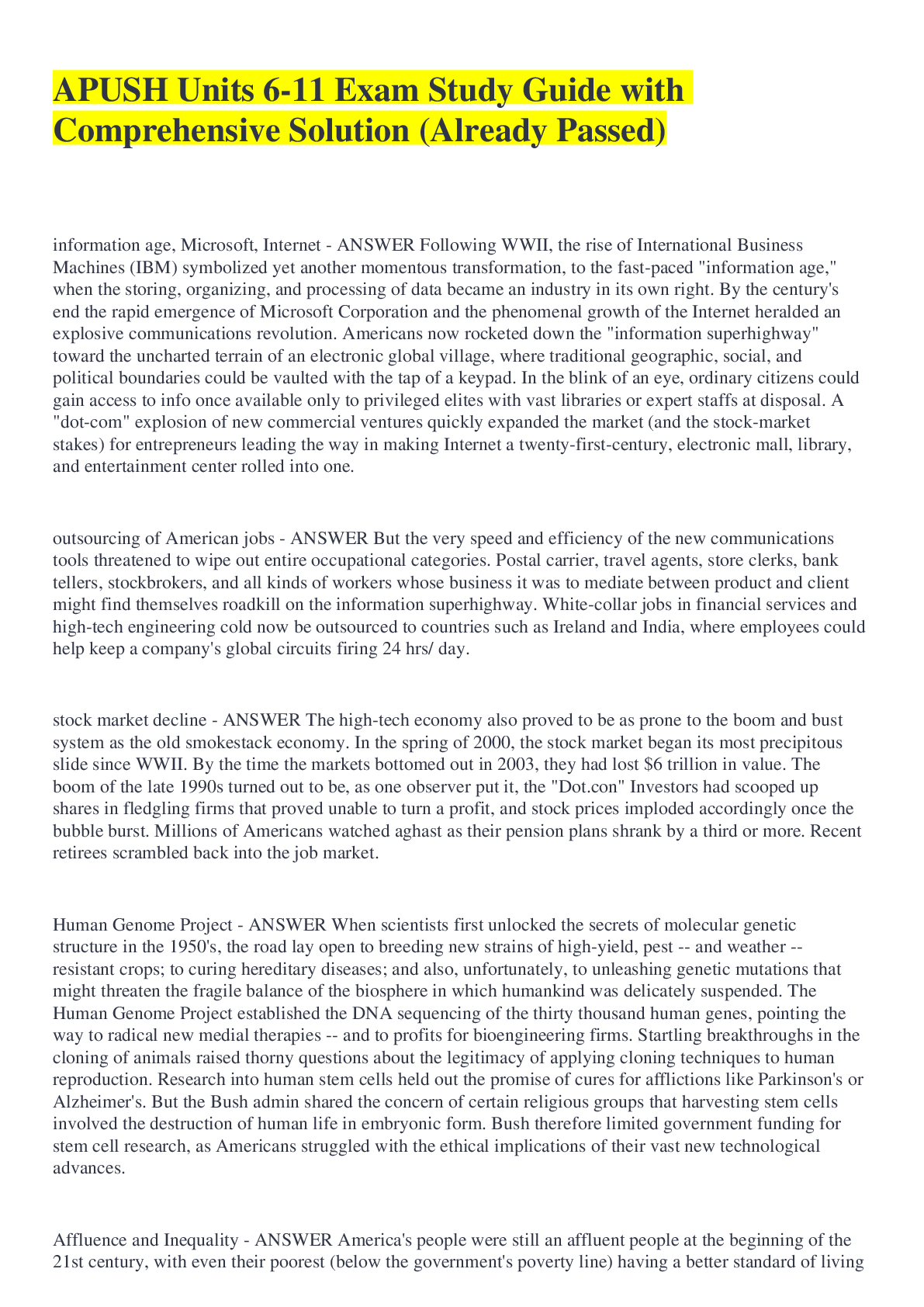
Buy this document to get the full access instantly
Instant Download Access after purchase
Buy NowInstant download
We Accept:

Also available in bundle (1)

APUSH Units 1,1-3,6-11 Exam Bundle complete full pack solved Solution
APUSH Unit 1Exam 2022/2023 answered 100% correct APUSH Units 1-3 Exam APUSH Units 6-11 Exam Study Guide with Comprehensive Solution (Already Passed)
By MARKALLAN 2 years ago
$18.5
3
Reviews( 0 )
$16.00
Can't find what you want? Try our AI powered Search
Document information
Connected school, study & course
About the document
Uploaded On
Sep 10, 2022
Number of pages
150
Written in
Additional information
This document has been written for:
Uploaded
Sep 10, 2022
Downloads
0
Views
64


